Business Research Methodology Assessment
VerifiedAdded on 2022/09/10
|12
|3870
|28
Assignment
AI Summary
Contribute Materials
Your contribution can guide someone’s learning journey. Share your
documents today.
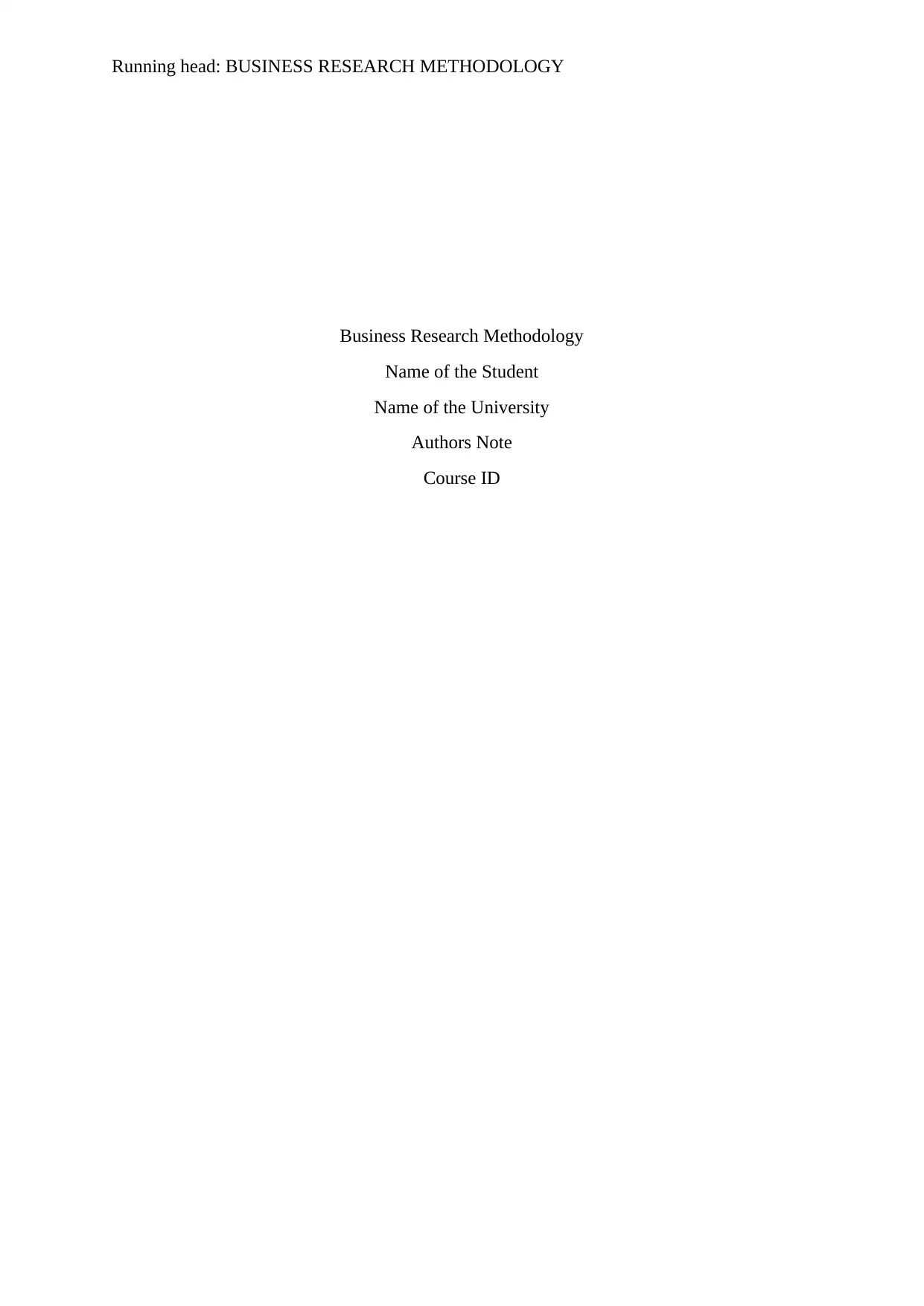
Running head: BUSINESS RESEARCH METHODOLOGY
Business Research Methodology
Name of the Student
Name of the University
Authors Note
Course ID
Business Research Methodology
Name of the Student
Name of the University
Authors Note
Course ID
Secure Best Marks with AI Grader
Need help grading? Try our AI Grader for instant feedback on your assignments.
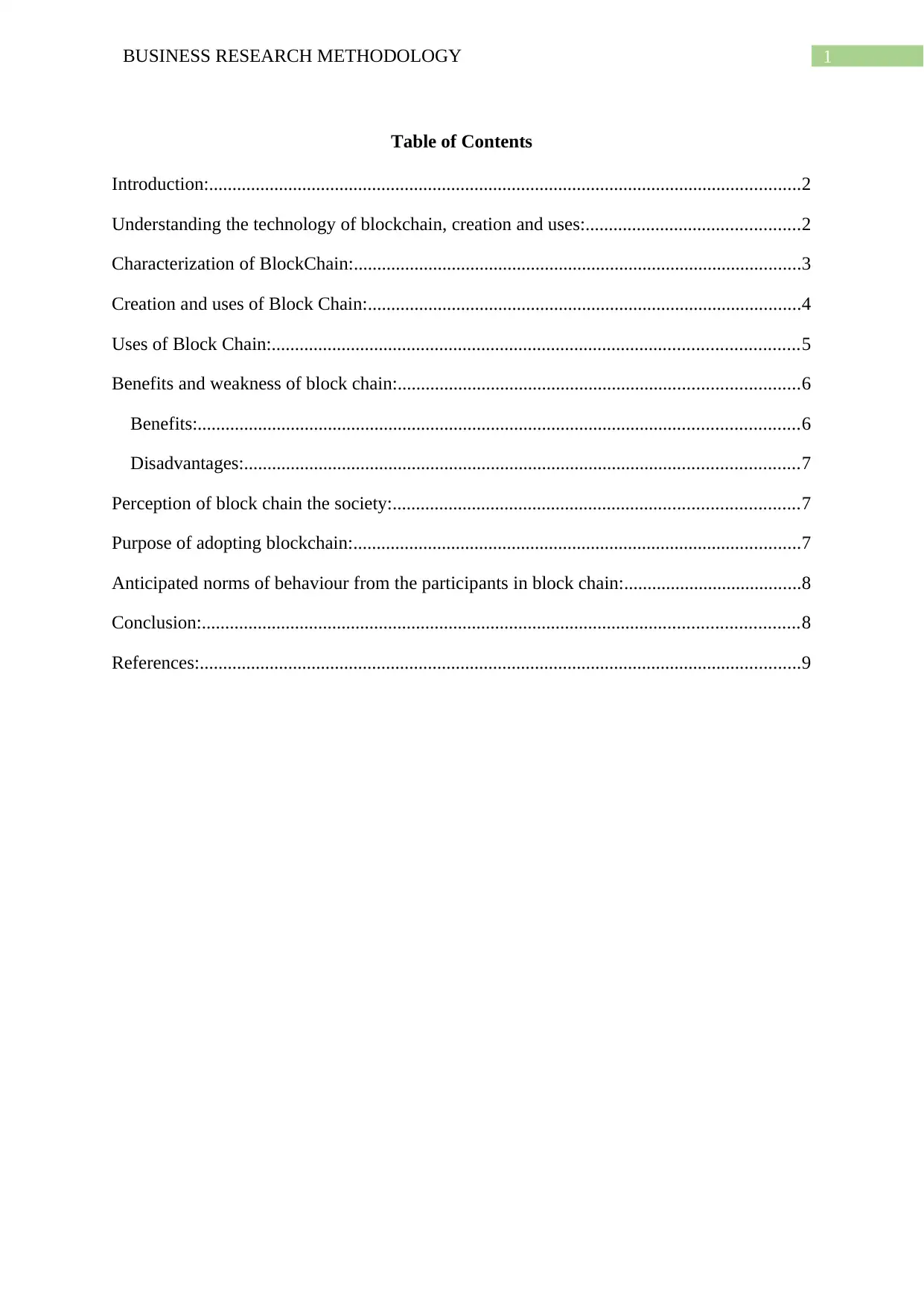
1BUSINESS RESEARCH METHODOLOGY
Table of Contents
Introduction:...............................................................................................................................2
Understanding the technology of blockchain, creation and uses:..............................................2
Characterization of BlockChain:................................................................................................3
Creation and uses of Block Chain:.............................................................................................4
Uses of Block Chain:.................................................................................................................5
Benefits and weakness of block chain:......................................................................................6
Benefits:.................................................................................................................................6
Disadvantages:.......................................................................................................................7
Perception of block chain the society:.......................................................................................7
Purpose of adopting blockchain:................................................................................................7
Anticipated norms of behaviour from the participants in block chain:......................................8
Conclusion:................................................................................................................................8
References:.................................................................................................................................9
Table of Contents
Introduction:...............................................................................................................................2
Understanding the technology of blockchain, creation and uses:..............................................2
Characterization of BlockChain:................................................................................................3
Creation and uses of Block Chain:.............................................................................................4
Uses of Block Chain:.................................................................................................................5
Benefits and weakness of block chain:......................................................................................6
Benefits:.................................................................................................................................6
Disadvantages:.......................................................................................................................7
Perception of block chain the society:.......................................................................................7
Purpose of adopting blockchain:................................................................................................7
Anticipated norms of behaviour from the participants in block chain:......................................8
Conclusion:................................................................................................................................8
References:.................................................................................................................................9

2BUSINESS RESEARCH METHODOLOGY
Introduction:
Blockchain, at times is referred as the “Distributed Ledger Technology (DLT)” which
makes the history of any kind of digital asset simply unalterable and clear as crystal by
making use of “decentralization” and “cryptographic” hashing. Blockchain is regarded as
the “public electronic ledger” which is built on the basis of P2P system that can be shared
openly amid the disparate users to form an unchangeable record of transactions every time
when it is stamped and linked with the previous one (Crosby et al., 2016). Each time a set of
transaction is added, that data turns into another block within the chain.
Blockchain can be only updated based on the consensus among the participants within
the system and once the data is entered then it is not possible to erase. The Blockchain
technology is regarded as the write-once, append several technology which makes it
verifiable and auditable record for each transaction. Even though Blockchain has huge
potential, the development of Blockchain technology is in the early days (Zheng et al., 2017).
The CIO and their business counterparts must anticipate setbacks in employing the
technology together with the probable serious bugs in the software that are used in
blockchain.
The present study is based on the understanding the technology of blockchain and
explaining its uses and characteristics. The study will be taking into the consideration
benefits, possibilities as well is limitation of the blockchain. The study will consider how the
Blockchain is perceived by the society and the ultimate purpose for which the technology of
blockchain is adopted.
Understanding the technology of blockchain, creation and uses:
Blockchain is regarded as the promising as well as revolutionary technology since it
helps in lowering the risk, stamping out the fraud and introduce transparency in a scalable
manner for the countless uses. For businesses nevertheless, blockchains carries the promise of
transactional transparency the ability of creating secure, actual time communication networks
with the partners across the world to support each thing for the supply chains to pay networks
to real estate deals and healthcare data sharing (Pilkington, 2016). The present hype
surrounding this relatively novel technology is considered actual since DLT, more
essentially, portray a newer paradigm for how the information can be shared; technology
vendors and enterprises, not surprisingly have rushed to understand how it can use the
distributed ledger technology to save both the time and administration costs. So the
Introduction:
Blockchain, at times is referred as the “Distributed Ledger Technology (DLT)” which
makes the history of any kind of digital asset simply unalterable and clear as crystal by
making use of “decentralization” and “cryptographic” hashing. Blockchain is regarded as
the “public electronic ledger” which is built on the basis of P2P system that can be shared
openly amid the disparate users to form an unchangeable record of transactions every time
when it is stamped and linked with the previous one (Crosby et al., 2016). Each time a set of
transaction is added, that data turns into another block within the chain.
Blockchain can be only updated based on the consensus among the participants within
the system and once the data is entered then it is not possible to erase. The Blockchain
technology is regarded as the write-once, append several technology which makes it
verifiable and auditable record for each transaction. Even though Blockchain has huge
potential, the development of Blockchain technology is in the early days (Zheng et al., 2017).
The CIO and their business counterparts must anticipate setbacks in employing the
technology together with the probable serious bugs in the software that are used in
blockchain.
The present study is based on the understanding the technology of blockchain and
explaining its uses and characteristics. The study will be taking into the consideration
benefits, possibilities as well is limitation of the blockchain. The study will consider how the
Blockchain is perceived by the society and the ultimate purpose for which the technology of
blockchain is adopted.
Understanding the technology of blockchain, creation and uses:
Blockchain is regarded as the promising as well as revolutionary technology since it
helps in lowering the risk, stamping out the fraud and introduce transparency in a scalable
manner for the countless uses. For businesses nevertheless, blockchains carries the promise of
transactional transparency the ability of creating secure, actual time communication networks
with the partners across the world to support each thing for the supply chains to pay networks
to real estate deals and healthcare data sharing (Pilkington, 2016). The present hype
surrounding this relatively novel technology is considered actual since DLT, more
essentially, portray a newer paradigm for how the information can be shared; technology
vendors and enterprises, not surprisingly have rushed to understand how it can use the
distributed ledger technology to save both the time and administration costs. So the
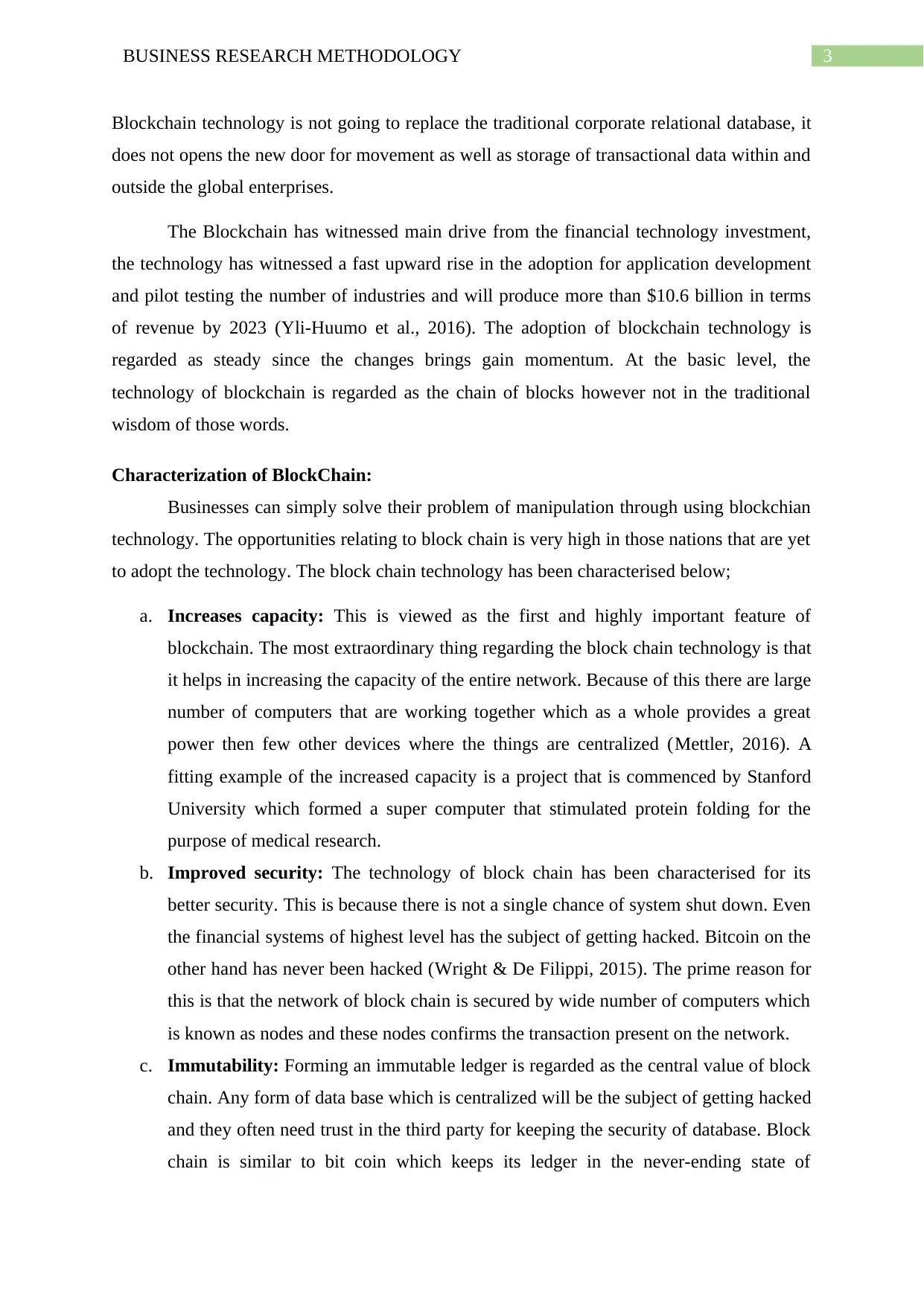
3BUSINESS RESEARCH METHODOLOGY
Blockchain technology is not going to replace the traditional corporate relational database, it
does not opens the new door for movement as well as storage of transactional data within and
outside the global enterprises.
The Blockchain has witnessed main drive from the financial technology investment,
the technology has witnessed a fast upward rise in the adoption for application development
and pilot testing the number of industries and will produce more than $10.6 billion in terms
of revenue by 2023 (Yli-Huumo et al., 2016). The adoption of blockchain technology is
regarded as steady since the changes brings gain momentum. At the basic level, the
technology of blockchain is regarded as the chain of blocks however not in the traditional
wisdom of those words.
Characterization of BlockChain:
Businesses can simply solve their problem of manipulation through using blockchian
technology. The opportunities relating to block chain is very high in those nations that are yet
to adopt the technology. The block chain technology has been characterised below;
a. Increases capacity: This is viewed as the first and highly important feature of
blockchain. The most extraordinary thing regarding the block chain technology is that
it helps in increasing the capacity of the entire network. Because of this there are large
number of computers that are working together which as a whole provides a great
power then few other devices where the things are centralized (Mettler, 2016). A
fitting example of the increased capacity is a project that is commenced by Stanford
University which formed a super computer that stimulated protein folding for the
purpose of medical research.
b. Improved security: The technology of block chain has been characterised for its
better security. This is because there is not a single chance of system shut down. Even
the financial systems of highest level has the subject of getting hacked. Bitcoin on the
other hand has never been hacked (Wright & De Filippi, 2015). The prime reason for
this is that the network of block chain is secured by wide number of computers which
is known as nodes and these nodes confirms the transaction present on the network.
c. Immutability: Forming an immutable ledger is regarded as the central value of block
chain. Any form of data base which is centralized will be the subject of getting hacked
and they often need trust in the third party for keeping the security of database. Block
chain is similar to bit coin which keeps its ledger in the never-ending state of
Blockchain technology is not going to replace the traditional corporate relational database, it
does not opens the new door for movement as well as storage of transactional data within and
outside the global enterprises.
The Blockchain has witnessed main drive from the financial technology investment,
the technology has witnessed a fast upward rise in the adoption for application development
and pilot testing the number of industries and will produce more than $10.6 billion in terms
of revenue by 2023 (Yli-Huumo et al., 2016). The adoption of blockchain technology is
regarded as steady since the changes brings gain momentum. At the basic level, the
technology of blockchain is regarded as the chain of blocks however not in the traditional
wisdom of those words.
Characterization of BlockChain:
Businesses can simply solve their problem of manipulation through using blockchian
technology. The opportunities relating to block chain is very high in those nations that are yet
to adopt the technology. The block chain technology has been characterised below;
a. Increases capacity: This is viewed as the first and highly important feature of
blockchain. The most extraordinary thing regarding the block chain technology is that
it helps in increasing the capacity of the entire network. Because of this there are large
number of computers that are working together which as a whole provides a great
power then few other devices where the things are centralized (Mettler, 2016). A
fitting example of the increased capacity is a project that is commenced by Stanford
University which formed a super computer that stimulated protein folding for the
purpose of medical research.
b. Improved security: The technology of block chain has been characterised for its
better security. This is because there is not a single chance of system shut down. Even
the financial systems of highest level has the subject of getting hacked. Bitcoin on the
other hand has never been hacked (Wright & De Filippi, 2015). The prime reason for
this is that the network of block chain is secured by wide number of computers which
is known as nodes and these nodes confirms the transaction present on the network.
c. Immutability: Forming an immutable ledger is regarded as the central value of block
chain. Any form of data base which is centralized will be the subject of getting hacked
and they often need trust in the third party for keeping the security of database. Block
chain is similar to bit coin which keeps its ledger in the never-ending state of
Secure Best Marks with AI Grader
Need help grading? Try our AI Grader for instant feedback on your assignments.
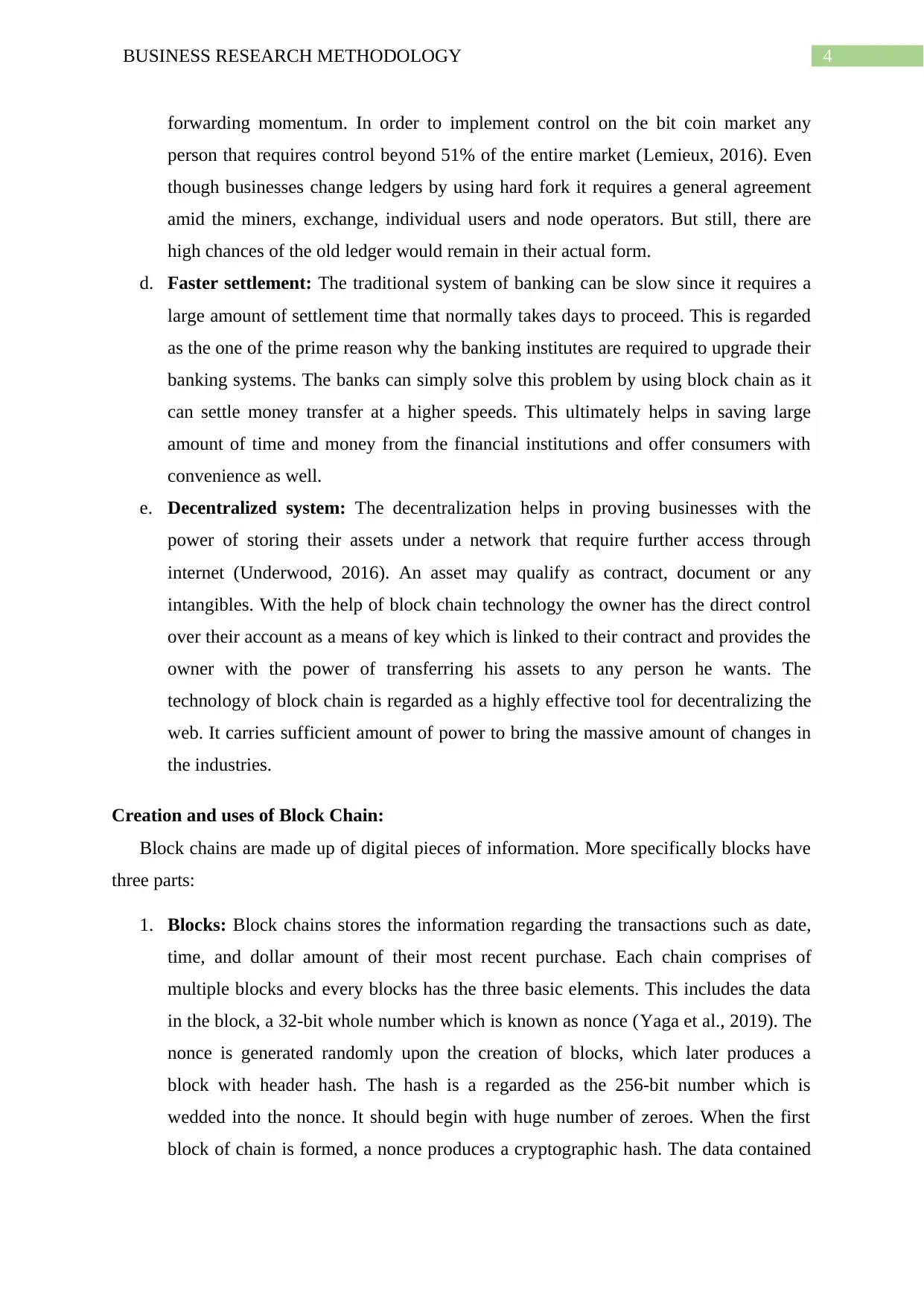
4BUSINESS RESEARCH METHODOLOGY
forwarding momentum. In order to implement control on the bit coin market any
person that requires control beyond 51% of the entire market (Lemieux, 2016). Even
though businesses change ledgers by using hard fork it requires a general agreement
amid the miners, exchange, individual users and node operators. But still, there are
high chances of the old ledger would remain in their actual form.
d. Faster settlement: The traditional system of banking can be slow since it requires a
large amount of settlement time that normally takes days to proceed. This is regarded
as the one of the prime reason why the banking institutes are required to upgrade their
banking systems. The banks can simply solve this problem by using block chain as it
can settle money transfer at a higher speeds. This ultimately helps in saving large
amount of time and money from the financial institutions and offer consumers with
convenience as well.
e. Decentralized system: The decentralization helps in proving businesses with the
power of storing their assets under a network that require further access through
internet (Underwood, 2016). An asset may qualify as contract, document or any
intangibles. With the help of block chain technology the owner has the direct control
over their account as a means of key which is linked to their contract and provides the
owner with the power of transferring his assets to any person he wants. The
technology of block chain is regarded as a highly effective tool for decentralizing the
web. It carries sufficient amount of power to bring the massive amount of changes in
the industries.
Creation and uses of Block Chain:
Block chains are made up of digital pieces of information. More specifically blocks have
three parts:
1. Blocks: Block chains stores the information regarding the transactions such as date,
time, and dollar amount of their most recent purchase. Each chain comprises of
multiple blocks and every blocks has the three basic elements. This includes the data
in the block, a 32-bit whole number which is known as nonce (Yaga et al., 2019). The
nonce is generated randomly upon the creation of blocks, which later produces a
block with header hash. The hash is a regarded as the 256-bit number which is
wedded into the nonce. It should begin with huge number of zeroes. When the first
block of chain is formed, a nonce produces a cryptographic hash. The data contained
forwarding momentum. In order to implement control on the bit coin market any
person that requires control beyond 51% of the entire market (Lemieux, 2016). Even
though businesses change ledgers by using hard fork it requires a general agreement
amid the miners, exchange, individual users and node operators. But still, there are
high chances of the old ledger would remain in their actual form.
d. Faster settlement: The traditional system of banking can be slow since it requires a
large amount of settlement time that normally takes days to proceed. This is regarded
as the one of the prime reason why the banking institutes are required to upgrade their
banking systems. The banks can simply solve this problem by using block chain as it
can settle money transfer at a higher speeds. This ultimately helps in saving large
amount of time and money from the financial institutions and offer consumers with
convenience as well.
e. Decentralized system: The decentralization helps in proving businesses with the
power of storing their assets under a network that require further access through
internet (Underwood, 2016). An asset may qualify as contract, document or any
intangibles. With the help of block chain technology the owner has the direct control
over their account as a means of key which is linked to their contract and provides the
owner with the power of transferring his assets to any person he wants. The
technology of block chain is regarded as a highly effective tool for decentralizing the
web. It carries sufficient amount of power to bring the massive amount of changes in
the industries.
Creation and uses of Block Chain:
Block chains are made up of digital pieces of information. More specifically blocks have
three parts:
1. Blocks: Block chains stores the information regarding the transactions such as date,
time, and dollar amount of their most recent purchase. Each chain comprises of
multiple blocks and every blocks has the three basic elements. This includes the data
in the block, a 32-bit whole number which is known as nonce (Yaga et al., 2019). The
nonce is generated randomly upon the creation of blocks, which later produces a
block with header hash. The hash is a regarded as the 256-bit number which is
wedded into the nonce. It should begin with huge number of zeroes. When the first
block of chain is formed, a nonce produces a cryptographic hash. The data contained
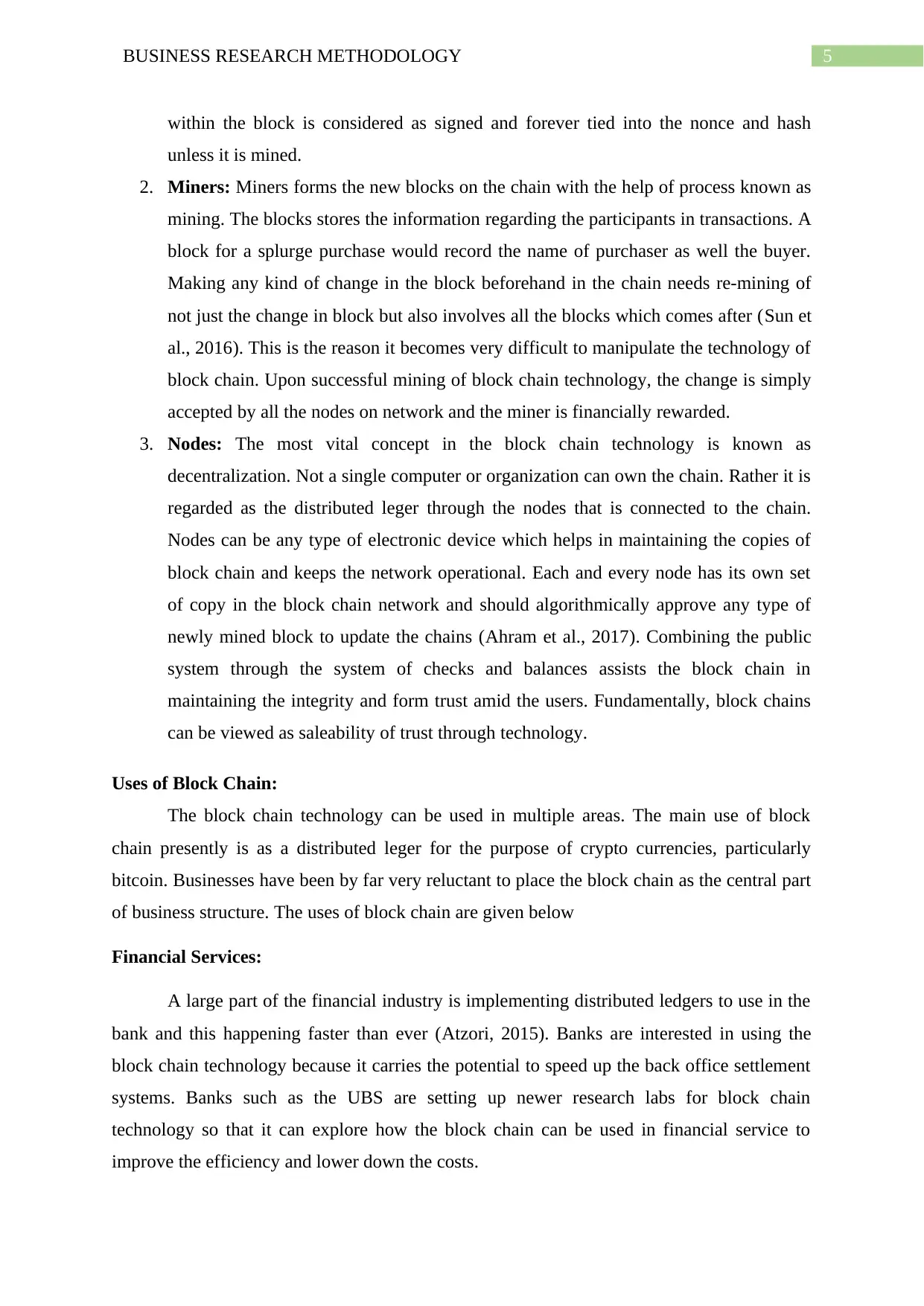
5BUSINESS RESEARCH METHODOLOGY
within the block is considered as signed and forever tied into the nonce and hash
unless it is mined.
2. Miners: Miners forms the new blocks on the chain with the help of process known as
mining. The blocks stores the information regarding the participants in transactions. A
block for a splurge purchase would record the name of purchaser as well the buyer.
Making any kind of change in the block beforehand in the chain needs re-mining of
not just the change in block but also involves all the blocks which comes after (Sun et
al., 2016). This is the reason it becomes very difficult to manipulate the technology of
block chain. Upon successful mining of block chain technology, the change is simply
accepted by all the nodes on network and the miner is financially rewarded.
3. Nodes: The most vital concept in the block chain technology is known as
decentralization. Not a single computer or organization can own the chain. Rather it is
regarded as the distributed leger through the nodes that is connected to the chain.
Nodes can be any type of electronic device which helps in maintaining the copies of
block chain and keeps the network operational. Each and every node has its own set
of copy in the block chain network and should algorithmically approve any type of
newly mined block to update the chains (Ahram et al., 2017). Combining the public
system through the system of checks and balances assists the block chain in
maintaining the integrity and form trust amid the users. Fundamentally, block chains
can be viewed as saleability of trust through technology.
Uses of Block Chain:
The block chain technology can be used in multiple areas. The main use of block
chain presently is as a distributed leger for the purpose of crypto currencies, particularly
bitcoin. Businesses have been by far very reluctant to place the block chain as the central part
of business structure. The uses of block chain are given below
Financial Services:
A large part of the financial industry is implementing distributed ledgers to use in the
bank and this happening faster than ever (Atzori, 2015). Banks are interested in using the
block chain technology because it carries the potential to speed up the back office settlement
systems. Banks such as the UBS are setting up newer research labs for block chain
technology so that it can explore how the block chain can be used in financial service to
improve the efficiency and lower down the costs.
within the block is considered as signed and forever tied into the nonce and hash
unless it is mined.
2. Miners: Miners forms the new blocks on the chain with the help of process known as
mining. The blocks stores the information regarding the participants in transactions. A
block for a splurge purchase would record the name of purchaser as well the buyer.
Making any kind of change in the block beforehand in the chain needs re-mining of
not just the change in block but also involves all the blocks which comes after (Sun et
al., 2016). This is the reason it becomes very difficult to manipulate the technology of
block chain. Upon successful mining of block chain technology, the change is simply
accepted by all the nodes on network and the miner is financially rewarded.
3. Nodes: The most vital concept in the block chain technology is known as
decentralization. Not a single computer or organization can own the chain. Rather it is
regarded as the distributed leger through the nodes that is connected to the chain.
Nodes can be any type of electronic device which helps in maintaining the copies of
block chain and keeps the network operational. Each and every node has its own set
of copy in the block chain network and should algorithmically approve any type of
newly mined block to update the chains (Ahram et al., 2017). Combining the public
system through the system of checks and balances assists the block chain in
maintaining the integrity and form trust amid the users. Fundamentally, block chains
can be viewed as saleability of trust through technology.
Uses of Block Chain:
The block chain technology can be used in multiple areas. The main use of block
chain presently is as a distributed leger for the purpose of crypto currencies, particularly
bitcoin. Businesses have been by far very reluctant to place the block chain as the central part
of business structure. The uses of block chain are given below
Financial Services:
A large part of the financial industry is implementing distributed ledgers to use in the
bank and this happening faster than ever (Atzori, 2015). Banks are interested in using the
block chain technology because it carries the potential to speed up the back office settlement
systems. Banks such as the UBS are setting up newer research labs for block chain
technology so that it can explore how the block chain can be used in financial service to
improve the efficiency and lower down the costs.
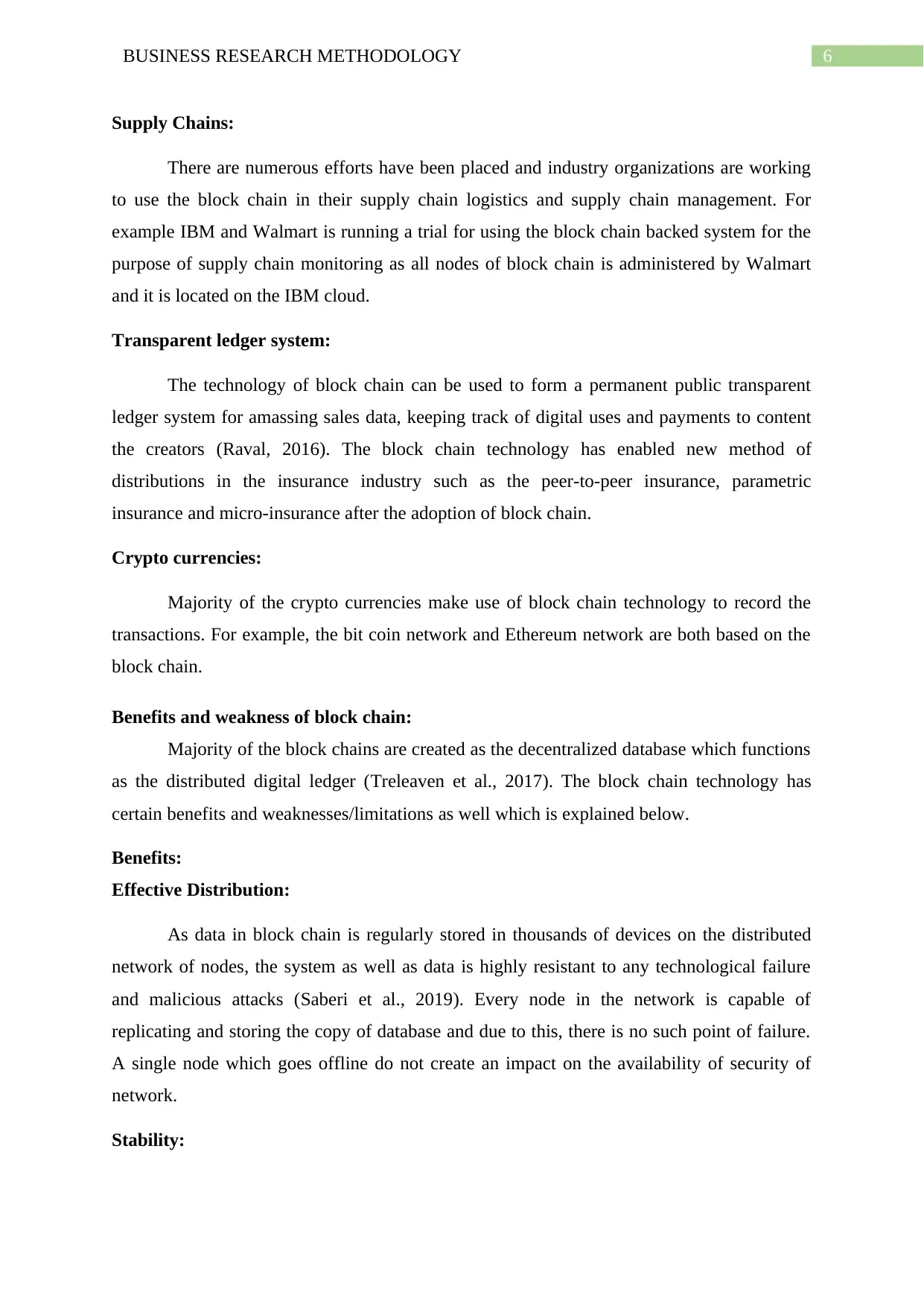
6BUSINESS RESEARCH METHODOLOGY
Supply Chains:
There are numerous efforts have been placed and industry organizations are working
to use the block chain in their supply chain logistics and supply chain management. For
example IBM and Walmart is running a trial for using the block chain backed system for the
purpose of supply chain monitoring as all nodes of block chain is administered by Walmart
and it is located on the IBM cloud.
Transparent ledger system:
The technology of block chain can be used to form a permanent public transparent
ledger system for amassing sales data, keeping track of digital uses and payments to content
the creators (Raval, 2016). The block chain technology has enabled new method of
distributions in the insurance industry such as the peer-to-peer insurance, parametric
insurance and micro-insurance after the adoption of block chain.
Crypto currencies:
Majority of the crypto currencies make use of block chain technology to record the
transactions. For example, the bit coin network and Ethereum network are both based on the
block chain.
Benefits and weakness of block chain:
Majority of the block chains are created as the decentralized database which functions
as the distributed digital ledger (Treleaven et al., 2017). The block chain technology has
certain benefits and weaknesses/limitations as well which is explained below.
Benefits:
Effective Distribution:
As data in block chain is regularly stored in thousands of devices on the distributed
network of nodes, the system as well as data is highly resistant to any technological failure
and malicious attacks (Saberi et al., 2019). Every node in the network is capable of
replicating and storing the copy of database and due to this, there is no such point of failure.
A single node which goes offline do not create an impact on the availability of security of
network.
Stability:
Supply Chains:
There are numerous efforts have been placed and industry organizations are working
to use the block chain in their supply chain logistics and supply chain management. For
example IBM and Walmart is running a trial for using the block chain backed system for the
purpose of supply chain monitoring as all nodes of block chain is administered by Walmart
and it is located on the IBM cloud.
Transparent ledger system:
The technology of block chain can be used to form a permanent public transparent
ledger system for amassing sales data, keeping track of digital uses and payments to content
the creators (Raval, 2016). The block chain technology has enabled new method of
distributions in the insurance industry such as the peer-to-peer insurance, parametric
insurance and micro-insurance after the adoption of block chain.
Crypto currencies:
Majority of the crypto currencies make use of block chain technology to record the
transactions. For example, the bit coin network and Ethereum network are both based on the
block chain.
Benefits and weakness of block chain:
Majority of the block chains are created as the decentralized database which functions
as the distributed digital ledger (Treleaven et al., 2017). The block chain technology has
certain benefits and weaknesses/limitations as well which is explained below.
Benefits:
Effective Distribution:
As data in block chain is regularly stored in thousands of devices on the distributed
network of nodes, the system as well as data is highly resistant to any technological failure
and malicious attacks (Saberi et al., 2019). Every node in the network is capable of
replicating and storing the copy of database and due to this, there is no such point of failure.
A single node which goes offline do not create an impact on the availability of security of
network.
Stability:
Paraphrase This Document
Need a fresh take? Get an instant paraphrase of this document with our AI Paraphraser
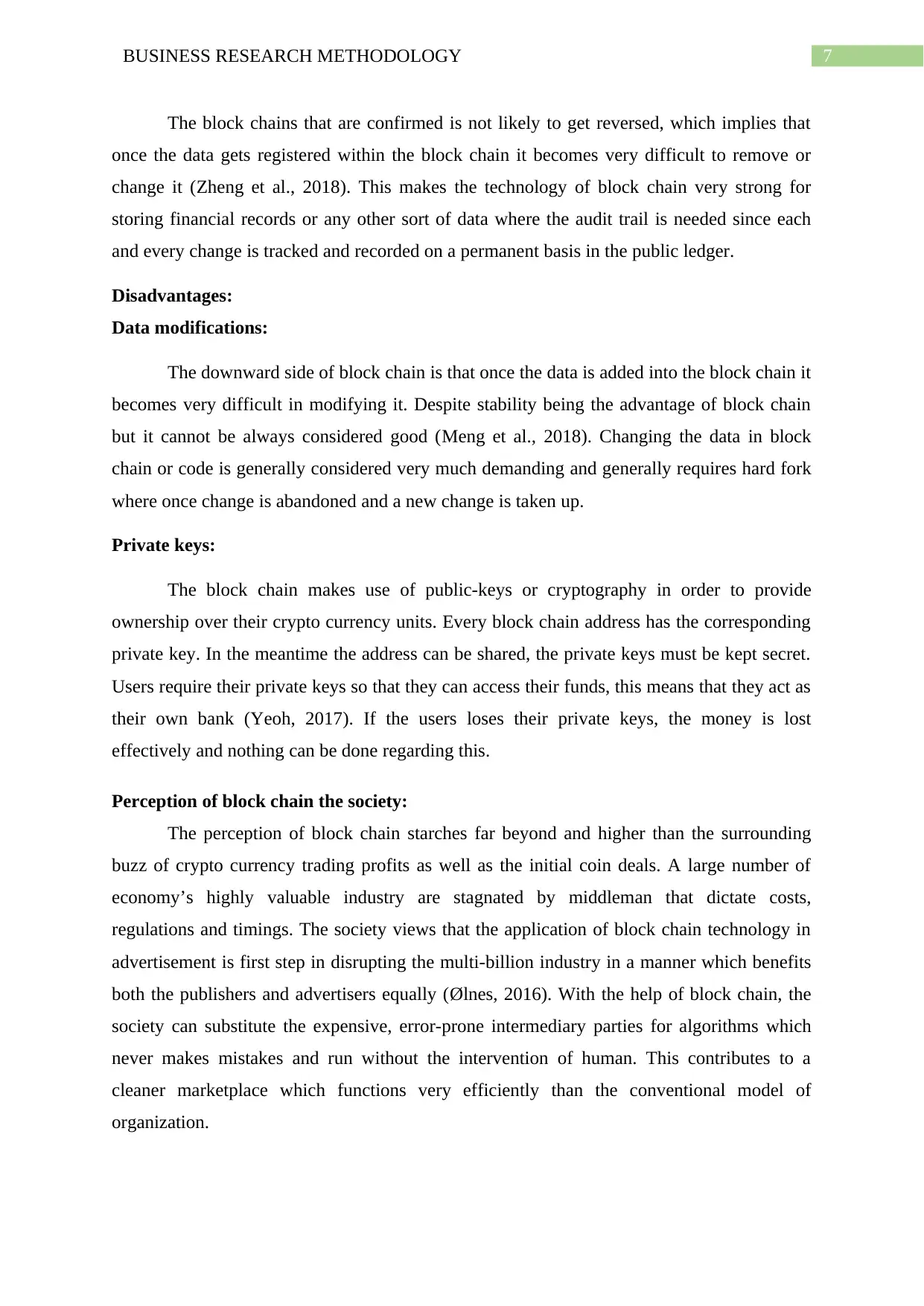
7BUSINESS RESEARCH METHODOLOGY
The block chains that are confirmed is not likely to get reversed, which implies that
once the data gets registered within the block chain it becomes very difficult to remove or
change it (Zheng et al., 2018). This makes the technology of block chain very strong for
storing financial records or any other sort of data where the audit trail is needed since each
and every change is tracked and recorded on a permanent basis in the public ledger.
Disadvantages:
Data modifications:
The downward side of block chain is that once the data is added into the block chain it
becomes very difficult in modifying it. Despite stability being the advantage of block chain
but it cannot be always considered good (Meng et al., 2018). Changing the data in block
chain or code is generally considered very much demanding and generally requires hard fork
where once change is abandoned and a new change is taken up.
Private keys:
The block chain makes use of public-keys or cryptography in order to provide
ownership over their crypto currency units. Every block chain address has the corresponding
private key. In the meantime the address can be shared, the private keys must be kept secret.
Users require their private keys so that they can access their funds, this means that they act as
their own bank (Yeoh, 2017). If the users loses their private keys, the money is lost
effectively and nothing can be done regarding this.
Perception of block chain the society:
The perception of block chain starches far beyond and higher than the surrounding
buzz of crypto currency trading profits as well as the initial coin deals. A large number of
economy’s highly valuable industry are stagnated by middleman that dictate costs,
regulations and timings. The society views that the application of block chain technology in
advertisement is first step in disrupting the multi-billion industry in a manner which benefits
both the publishers and advertisers equally (Ølnes, 2016). With the help of block chain, the
society can substitute the expensive, error-prone intermediary parties for algorithms which
never makes mistakes and run without the intervention of human. This contributes to a
cleaner marketplace which functions very efficiently than the conventional model of
organization.
The block chains that are confirmed is not likely to get reversed, which implies that
once the data gets registered within the block chain it becomes very difficult to remove or
change it (Zheng et al., 2018). This makes the technology of block chain very strong for
storing financial records or any other sort of data where the audit trail is needed since each
and every change is tracked and recorded on a permanent basis in the public ledger.
Disadvantages:
Data modifications:
The downward side of block chain is that once the data is added into the block chain it
becomes very difficult in modifying it. Despite stability being the advantage of block chain
but it cannot be always considered good (Meng et al., 2018). Changing the data in block
chain or code is generally considered very much demanding and generally requires hard fork
where once change is abandoned and a new change is taken up.
Private keys:
The block chain makes use of public-keys or cryptography in order to provide
ownership over their crypto currency units. Every block chain address has the corresponding
private key. In the meantime the address can be shared, the private keys must be kept secret.
Users require their private keys so that they can access their funds, this means that they act as
their own bank (Yeoh, 2017). If the users loses their private keys, the money is lost
effectively and nothing can be done regarding this.
Perception of block chain the society:
The perception of block chain starches far beyond and higher than the surrounding
buzz of crypto currency trading profits as well as the initial coin deals. A large number of
economy’s highly valuable industry are stagnated by middleman that dictate costs,
regulations and timings. The society views that the application of block chain technology in
advertisement is first step in disrupting the multi-billion industry in a manner which benefits
both the publishers and advertisers equally (Ølnes, 2016). With the help of block chain, the
society can substitute the expensive, error-prone intermediary parties for algorithms which
never makes mistakes and run without the intervention of human. This contributes to a
cleaner marketplace which functions very efficiently than the conventional model of
organization.
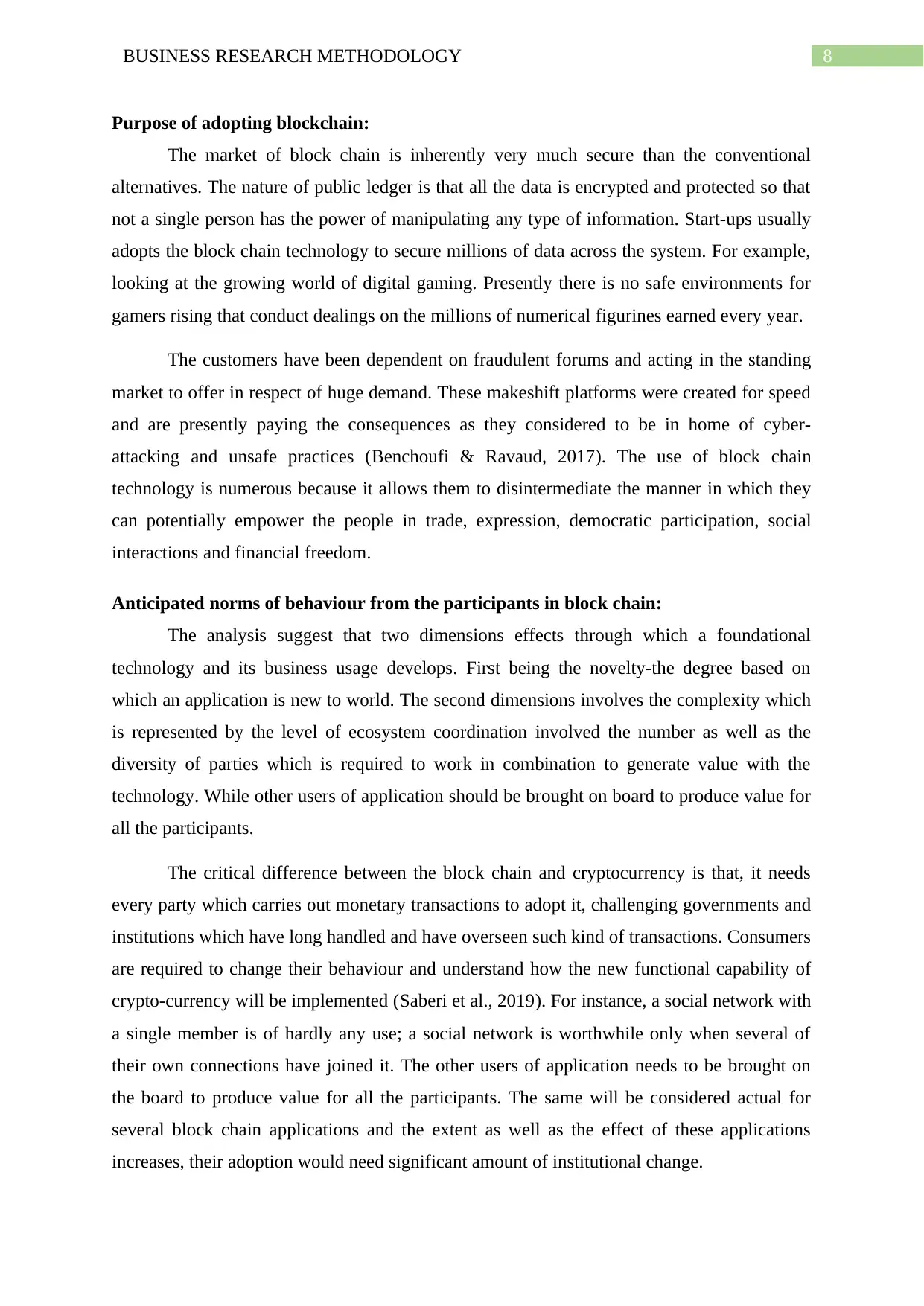
8BUSINESS RESEARCH METHODOLOGY
Purpose of adopting blockchain:
The market of block chain is inherently very much secure than the conventional
alternatives. The nature of public ledger is that all the data is encrypted and protected so that
not a single person has the power of manipulating any type of information. Start-ups usually
adopts the block chain technology to secure millions of data across the system. For example,
looking at the growing world of digital gaming. Presently there is no safe environments for
gamers rising that conduct dealings on the millions of numerical figurines earned every year.
The customers have been dependent on fraudulent forums and acting in the standing
market to offer in respect of huge demand. These makeshift platforms were created for speed
and are presently paying the consequences as they considered to be in home of cyber-
attacking and unsafe practices (Benchoufi & Ravaud, 2017). The use of block chain
technology is numerous because it allows them to disintermediate the manner in which they
can potentially empower the people in trade, expression, democratic participation, social
interactions and financial freedom.
Anticipated norms of behaviour from the participants in block chain:
The analysis suggest that two dimensions effects through which a foundational
technology and its business usage develops. First being the novelty-the degree based on
which an application is new to world. The second dimensions involves the complexity which
is represented by the level of ecosystem coordination involved the number as well as the
diversity of parties which is required to work in combination to generate value with the
technology. While other users of application should be brought on board to produce value for
all the participants.
The critical difference between the block chain and cryptocurrency is that, it needs
every party which carries out monetary transactions to adopt it, challenging governments and
institutions which have long handled and have overseen such kind of transactions. Consumers
are required to change their behaviour and understand how the new functional capability of
crypto-currency will be implemented (Saberi et al., 2019). For instance, a social network with
a single member is of hardly any use; a social network is worthwhile only when several of
their own connections have joined it. The other users of application needs to be brought on
the board to produce value for all the participants. The same will be considered actual for
several block chain applications and the extent as well as the effect of these applications
increases, their adoption would need significant amount of institutional change.
Purpose of adopting blockchain:
The market of block chain is inherently very much secure than the conventional
alternatives. The nature of public ledger is that all the data is encrypted and protected so that
not a single person has the power of manipulating any type of information. Start-ups usually
adopts the block chain technology to secure millions of data across the system. For example,
looking at the growing world of digital gaming. Presently there is no safe environments for
gamers rising that conduct dealings on the millions of numerical figurines earned every year.
The customers have been dependent on fraudulent forums and acting in the standing
market to offer in respect of huge demand. These makeshift platforms were created for speed
and are presently paying the consequences as they considered to be in home of cyber-
attacking and unsafe practices (Benchoufi & Ravaud, 2017). The use of block chain
technology is numerous because it allows them to disintermediate the manner in which they
can potentially empower the people in trade, expression, democratic participation, social
interactions and financial freedom.
Anticipated norms of behaviour from the participants in block chain:
The analysis suggest that two dimensions effects through which a foundational
technology and its business usage develops. First being the novelty-the degree based on
which an application is new to world. The second dimensions involves the complexity which
is represented by the level of ecosystem coordination involved the number as well as the
diversity of parties which is required to work in combination to generate value with the
technology. While other users of application should be brought on board to produce value for
all the participants.
The critical difference between the block chain and cryptocurrency is that, it needs
every party which carries out monetary transactions to adopt it, challenging governments and
institutions which have long handled and have overseen such kind of transactions. Consumers
are required to change their behaviour and understand how the new functional capability of
crypto-currency will be implemented (Saberi et al., 2019). For instance, a social network with
a single member is of hardly any use; a social network is worthwhile only when several of
their own connections have joined it. The other users of application needs to be brought on
the board to produce value for all the participants. The same will be considered actual for
several block chain applications and the extent as well as the effect of these applications
increases, their adoption would need significant amount of institutional change.
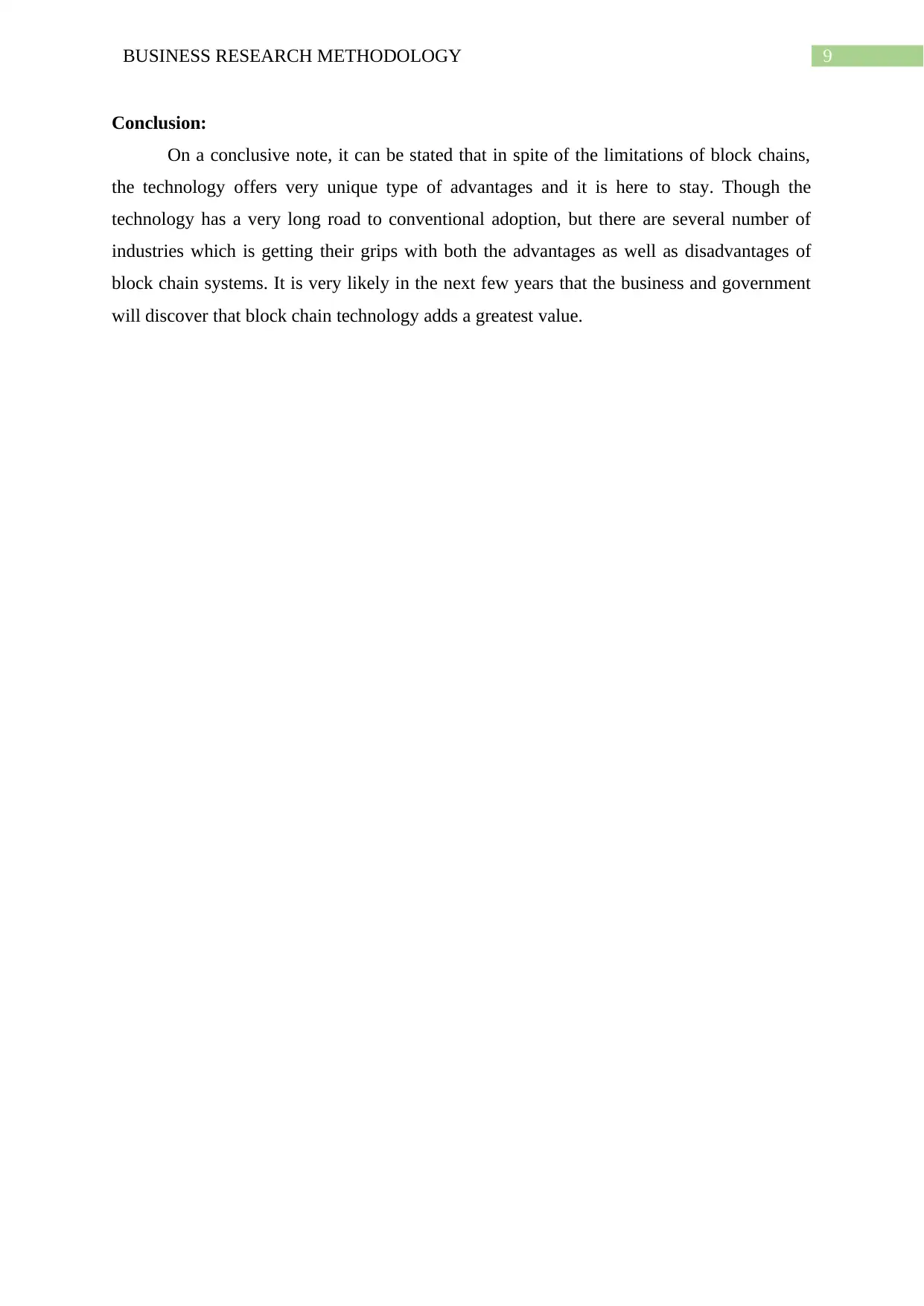
9BUSINESS RESEARCH METHODOLOGY
Conclusion:
On a conclusive note, it can be stated that in spite of the limitations of block chains,
the technology offers very unique type of advantages and it is here to stay. Though the
technology has a very long road to conventional adoption, but there are several number of
industries which is getting their grips with both the advantages as well as disadvantages of
block chain systems. It is very likely in the next few years that the business and government
will discover that block chain technology adds a greatest value.
Conclusion:
On a conclusive note, it can be stated that in spite of the limitations of block chains,
the technology offers very unique type of advantages and it is here to stay. Though the
technology has a very long road to conventional adoption, but there are several number of
industries which is getting their grips with both the advantages as well as disadvantages of
block chain systems. It is very likely in the next few years that the business and government
will discover that block chain technology adds a greatest value.
Secure Best Marks with AI Grader
Need help grading? Try our AI Grader for instant feedback on your assignments.
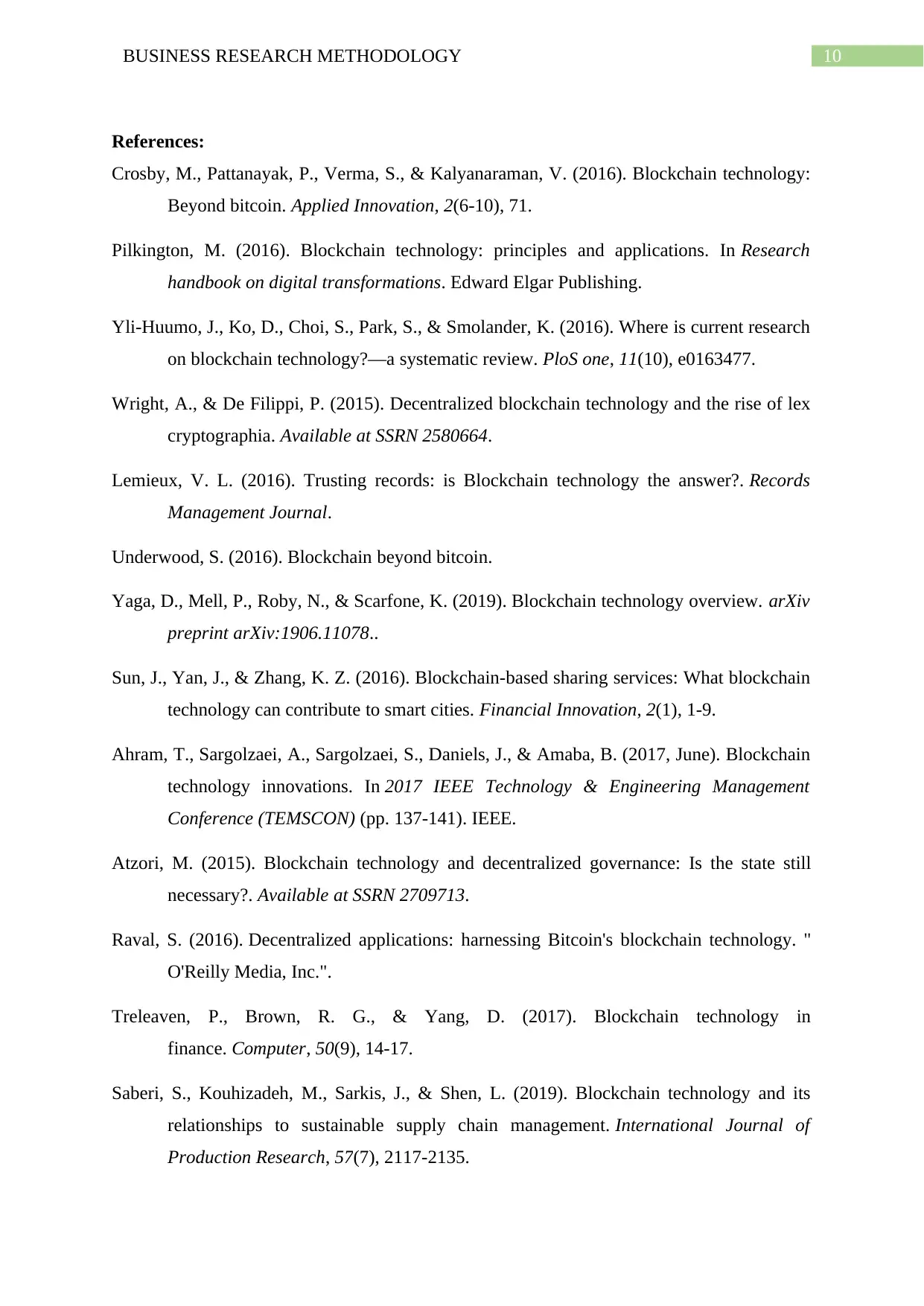
10BUSINESS RESEARCH METHODOLOGY
References:
Crosby, M., Pattanayak, P., Verma, S., & Kalyanaraman, V. (2016). Blockchain technology:
Beyond bitcoin. Applied Innovation, 2(6-10), 71.
Pilkington, M. (2016). Blockchain technology: principles and applications. In Research
handbook on digital transformations. Edward Elgar Publishing.
Yli-Huumo, J., Ko, D., Choi, S., Park, S., & Smolander, K. (2016). Where is current research
on blockchain technology?—a systematic review. PloS one, 11(10), e0163477.
Wright, A., & De Filippi, P. (2015). Decentralized blockchain technology and the rise of lex
cryptographia. Available at SSRN 2580664.
Lemieux, V. L. (2016). Trusting records: is Blockchain technology the answer?. Records
Management Journal.
Underwood, S. (2016). Blockchain beyond bitcoin.
Yaga, D., Mell, P., Roby, N., & Scarfone, K. (2019). Blockchain technology overview. arXiv
preprint arXiv:1906.11078..
Sun, J., Yan, J., & Zhang, K. Z. (2016). Blockchain-based sharing services: What blockchain
technology can contribute to smart cities. Financial Innovation, 2(1), 1-9.
Ahram, T., Sargolzaei, A., Sargolzaei, S., Daniels, J., & Amaba, B. (2017, June). Blockchain
technology innovations. In 2017 IEEE Technology & Engineering Management
Conference (TEMSCON) (pp. 137-141). IEEE.
Atzori, M. (2015). Blockchain technology and decentralized governance: Is the state still
necessary?. Available at SSRN 2709713.
Raval, S. (2016). Decentralized applications: harnessing Bitcoin's blockchain technology. "
O'Reilly Media, Inc.".
Treleaven, P., Brown, R. G., & Yang, D. (2017). Blockchain technology in
finance. Computer, 50(9), 14-17.
Saberi, S., Kouhizadeh, M., Sarkis, J., & Shen, L. (2019). Blockchain technology and its
relationships to sustainable supply chain management. International Journal of
Production Research, 57(7), 2117-2135.
References:
Crosby, M., Pattanayak, P., Verma, S., & Kalyanaraman, V. (2016). Blockchain technology:
Beyond bitcoin. Applied Innovation, 2(6-10), 71.
Pilkington, M. (2016). Blockchain technology: principles and applications. In Research
handbook on digital transformations. Edward Elgar Publishing.
Yli-Huumo, J., Ko, D., Choi, S., Park, S., & Smolander, K. (2016). Where is current research
on blockchain technology?—a systematic review. PloS one, 11(10), e0163477.
Wright, A., & De Filippi, P. (2015). Decentralized blockchain technology and the rise of lex
cryptographia. Available at SSRN 2580664.
Lemieux, V. L. (2016). Trusting records: is Blockchain technology the answer?. Records
Management Journal.
Underwood, S. (2016). Blockchain beyond bitcoin.
Yaga, D., Mell, P., Roby, N., & Scarfone, K. (2019). Blockchain technology overview. arXiv
preprint arXiv:1906.11078..
Sun, J., Yan, J., & Zhang, K. Z. (2016). Blockchain-based sharing services: What blockchain
technology can contribute to smart cities. Financial Innovation, 2(1), 1-9.
Ahram, T., Sargolzaei, A., Sargolzaei, S., Daniels, J., & Amaba, B. (2017, June). Blockchain
technology innovations. In 2017 IEEE Technology & Engineering Management
Conference (TEMSCON) (pp. 137-141). IEEE.
Atzori, M. (2015). Blockchain technology and decentralized governance: Is the state still
necessary?. Available at SSRN 2709713.
Raval, S. (2016). Decentralized applications: harnessing Bitcoin's blockchain technology. "
O'Reilly Media, Inc.".
Treleaven, P., Brown, R. G., & Yang, D. (2017). Blockchain technology in
finance. Computer, 50(9), 14-17.
Saberi, S., Kouhizadeh, M., Sarkis, J., & Shen, L. (2019). Blockchain technology and its
relationships to sustainable supply chain management. International Journal of
Production Research, 57(7), 2117-2135.
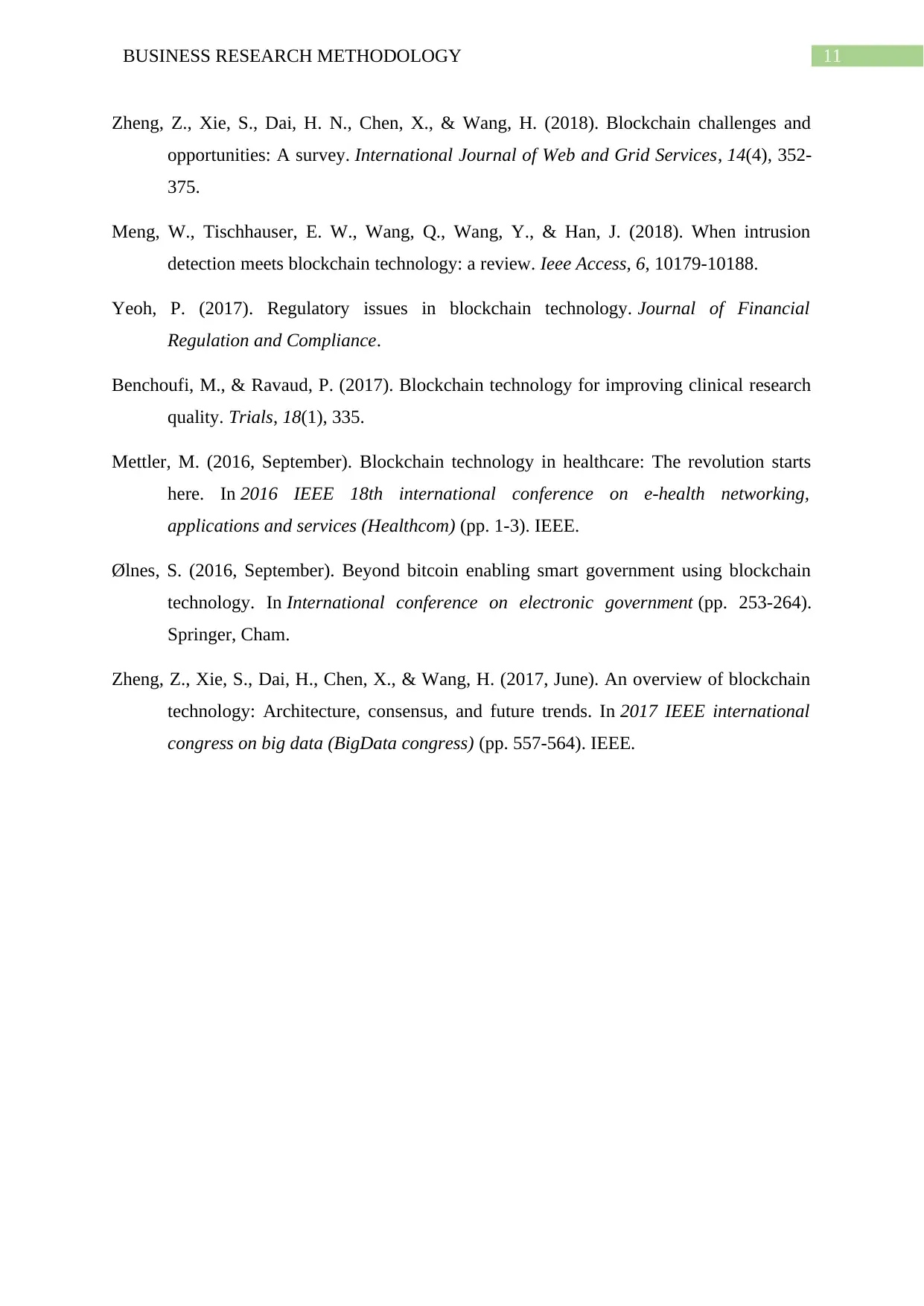
11BUSINESS RESEARCH METHODOLOGY
Zheng, Z., Xie, S., Dai, H. N., Chen, X., & Wang, H. (2018). Blockchain challenges and
opportunities: A survey. International Journal of Web and Grid Services, 14(4), 352-
375.
Meng, W., Tischhauser, E. W., Wang, Q., Wang, Y., & Han, J. (2018). When intrusion
detection meets blockchain technology: a review. Ieee Access, 6, 10179-10188.
Yeoh, P. (2017). Regulatory issues in blockchain technology. Journal of Financial
Regulation and Compliance.
Benchoufi, M., & Ravaud, P. (2017). Blockchain technology for improving clinical research
quality. Trials, 18(1), 335.
Mettler, M. (2016, September). Blockchain technology in healthcare: The revolution starts
here. In 2016 IEEE 18th international conference on e-health networking,
applications and services (Healthcom) (pp. 1-3). IEEE.
Ølnes, S. (2016, September). Beyond bitcoin enabling smart government using blockchain
technology. In International conference on electronic government (pp. 253-264).
Springer, Cham.
Zheng, Z., Xie, S., Dai, H., Chen, X., & Wang, H. (2017, June). An overview of blockchain
technology: Architecture, consensus, and future trends. In 2017 IEEE international
congress on big data (BigData congress) (pp. 557-564). IEEE.
Zheng, Z., Xie, S., Dai, H. N., Chen, X., & Wang, H. (2018). Blockchain challenges and
opportunities: A survey. International Journal of Web and Grid Services, 14(4), 352-
375.
Meng, W., Tischhauser, E. W., Wang, Q., Wang, Y., & Han, J. (2018). When intrusion
detection meets blockchain technology: a review. Ieee Access, 6, 10179-10188.
Yeoh, P. (2017). Regulatory issues in blockchain technology. Journal of Financial
Regulation and Compliance.
Benchoufi, M., & Ravaud, P. (2017). Blockchain technology for improving clinical research
quality. Trials, 18(1), 335.
Mettler, M. (2016, September). Blockchain technology in healthcare: The revolution starts
here. In 2016 IEEE 18th international conference on e-health networking,
applications and services (Healthcom) (pp. 1-3). IEEE.
Ølnes, S. (2016, September). Beyond bitcoin enabling smart government using blockchain
technology. In International conference on electronic government (pp. 253-264).
Springer, Cham.
Zheng, Z., Xie, S., Dai, H., Chen, X., & Wang, H. (2017, June). An overview of blockchain
technology: Architecture, consensus, and future trends. In 2017 IEEE international
congress on big data (BigData congress) (pp. 557-564). IEEE.
1 out of 12
Related Documents
Your All-in-One AI-Powered Toolkit for Academic Success.
+13062052269
info@desklib.com
Available 24*7 on WhatsApp / Email
![[object Object]](/_next/static/media/star-bottom.7253800d.svg)
Unlock your academic potential
© 2024 | Zucol Services PVT LTD | All rights reserved.





